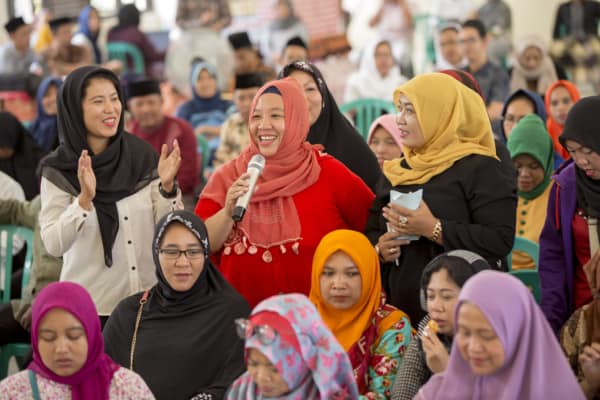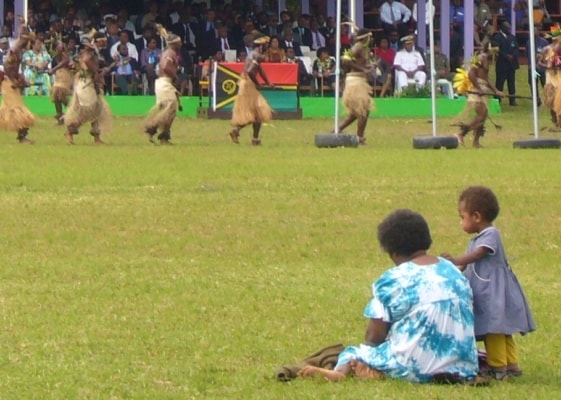Image: Anne Marie Tiani, a senior scientist for Center for International Forestry (CIFOR) and the coordinator for project COBAM, conducts a workshop in the DRC. (Ollivier Girard / CIFOR.)
Donors have recently made great efforts to understand power in partner countries. Yet they have largely ignored one of the most pervasive power relations – gender.
Gender shapes power, from the ‘private’ relationships of the household to the highest levels of political decision-making. However, as readers of Duncan Green’s blog have pointed out, calls for development practitioners to place power at the centre of their efforts and to ‘think and work politically’ (TWP) usually forget about gender. Similarly, donors’ analyses of the distribution of power and resources in partner countries generally make only the most superficial reference to gender, if they mention it at all.
In a new DLP Concept Brief, I argue that development work could be both more politically smart and more effective if it addressed this blind spot, focusing on six intimate links between gender and power.
Gender divides power. Inequalities between men and women are one of the most persistent patterns in the distribution of power. For example, women’s lack of influence marks political decision-making the world over.
Gender relations are power relations. Often what it means to be a ‘woman’ is to be powerless (quiet, obedient, accommodating). A ‘real man’, by contrast, is powerful (outspoken, in control, able to impose his will), particularly in relation to women. These gender roles tend to perpetuate the power inequalities that they are based on. For example, the fact that many men and women think it’s not ‘natural’ for women to speak up in public often poses a key barrier to women’s access to decision-making. ‘Power equals masculinity’ also helps explain why powerful people often demonstrate dominance in gendered ways. In Malawi, for example, leaders have traditionally asserted their ‘big man’ status by getting women to offer sexual ‘favours’ to party leaders and functionaries. As a result they have established “the mobilisation of women in subordinate and exploitative roles as an enduring feature of Malawi’s political system.”
The family is an arena of power and politics. Power dynamics in families and households interact with those in the ‘public’ sphere in shaping development outcomes. In Sri Lanka, increased female employment and access to resources challenged power relations between men and women in households, and often led to conflict in families. This, paradoxically, brought about a resurgence of social control over women, seen at its most extreme when some NGOs employing female local staff received bomb threats.
Gender shapes power inequalities based on other divisions, such as class and ethnicity, and vice versa. In Sri Lanka, for example, a power analysis revealed that almost all women parliamentarians were related to male politicians from powerful political families. The vast majority also came from the dominant Sinhalese ethnic group. Opposition to opening up more parliamentary seats for women representing women therefore “not only stems from a reluctance to share power with women, but also from a reluctance to enable women outside the main ‘political culture’ to access seats of power and authority.”
Gender shapes institutions and how they affect the distribution of power. Most political and economic institutions, historically dominated by men, are tailored to (elite) men’s experience. They idealise ‘masculine’ forms of behaviour and rely on men’s power over women. Therefore these institutions tend to ‘lock in’ two types of power – men’s power over women, and the power of the most ‘masculine’ men over everyone. Take political parties. They are key gatekeepers for women’s political participation, but their male-dominated cultures often make them inaccessible to women. In Burundi and Kosovo, for example, female politicians have complained that important party decisions were taken in bars – spaces women often can’t access.
Gender shapes how we understand what ‘power’ is in the first place. The widely accepted definition of power is getting someone else to do what you want them to do. Arguably this reflects a specifically male experience of the world: a place inhabited by hostile ‘others’ with whom, to survive, you are forced to forge some kind of social relationship. Women, particularly in their socially assigned roles of wife and mother, may more often understand themselves as being in continuity with the people around them rather than in opposition. They often aim to build capacity in others rather than to dominate. This would suggest an alternative idea of power: the capacity to transform and empower yourself and others. Amongst other things this alternative perspective highlights that women can sometimes have special forms of influence on decision-making because of their specific social status. In Liberia, for example, women working for peace were able to achieve high levels of trust among opposing factions by emphasising their non-threatening roles as sisters, mothers and wives.
So gender and power are intrinsically linked; understanding this can help us understand both concepts better and creates the opportunity that I hint at in the title of this piece – an opportunity for more politically smart development. It does this by offering two really practical pieces of advice:
If we think about gender, we’re better at thinking and working politically. A gender perspective shows that the PEA and TWP agendas are currently blind to key components of the workings of power: how power and politics in the family shape power relations at all levels of society; how wider economic, political and social structures rely on and reproduce gender power relations; and how feminised sources of power offer new opportunities for peace and prosperity. Addressing these blind spots can help us be more politically savvy. And that’s good for development outcomes.
If we think politically, we’re better at supporting gender equality. A power perspective shows that gender inequalities are tied to power relations at all levels of society. So gender inequalities are deeply political and if we want to help tackle them we must address them as such. To do this, among other things, we need to develop a deeper understanding of local context; focus on a wider range of powerful actors; and, importantly, take a closer look at the gendered power relations within donor country organisations.
To end on some really good news for more politically-savvy, more effective development work: I have heard rumours that the ‘TWP crew’ is planning to talk more about gender soon. Looking forward to an FP2P post about it!
For more articles and blogs on gender, click here. Join the conversation on Twitter @Dlprog, #LeadershipObvs.








